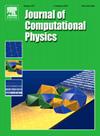Projected Langevin Monte Carlo algorithms in non-convex and super-linear setting
IF 3.8
2区 物理与天体物理
Q2 COMPUTER SCIENCE, INTERDISCIPLINARY APPLICATIONS
引用次数: 0
Abstract
It is of significant interest in many applications to sample from a high-dimensional target distribution π with the density , based on the temporal discretization of the Langevin stochastic differential equations (SDEs). In this paper, we propose an explicit projected Langevin Monte Carlo (PLMC) algorithm with non-convex potential U and super-linear gradient of U and investigate the non-asymptotic analysis of its sampling error in total variation distance. Equipped with time-independent regularity estimates for the associated Kolmogorov equation, we derive the non-asymptotic bounds on the total variation distance between the target distribution of the Langevin SDEs and the law induced by the PLMC scheme with order , where d is the dimension of the target distribution and characterizes the growth of the gradient of U. In addition, if the gradient of U is globally Lipschitz continuous, an improved convergence order of for the classical Langevin Monte Carlo (LMC) scheme is derived with a refinement of the proof based on Malliavin calculus techniques. To achieve a given precision ϵ, the smallest number of iterations of the PLMC algorithm is proved to be of order . In particular, the classical Langevin Monte Carlo (LMC) scheme with the non-convex potential U and the globally Lipschitz gradient of U can be guaranteed by order . Numerical experiments are provided to confirm the theoretical findings.
求助全文
约1分钟内获得全文
求助全文
来源期刊

Journal of Computational Physics
物理-计算机:跨学科应用
CiteScore
7.60
自引率
14.60%
发文量
763
审稿时长
5.8 months
期刊介绍:
Journal of Computational Physics thoroughly treats the computational aspects of physical problems, presenting techniques for the numerical solution of mathematical equations arising in all areas of physics. The journal seeks to emphasize methods that cross disciplinary boundaries.
The Journal of Computational Physics also publishes short notes of 4 pages or less (including figures, tables, and references but excluding title pages). Letters to the Editor commenting on articles already published in this Journal will also be considered. Neither notes nor letters should have an abstract.
 求助内容:
求助内容: 应助结果提醒方式:
应助结果提醒方式:


